

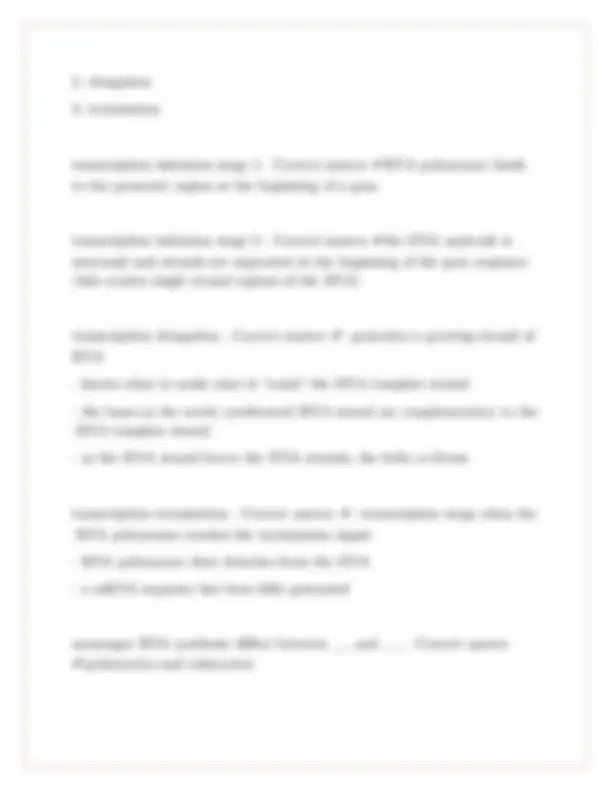

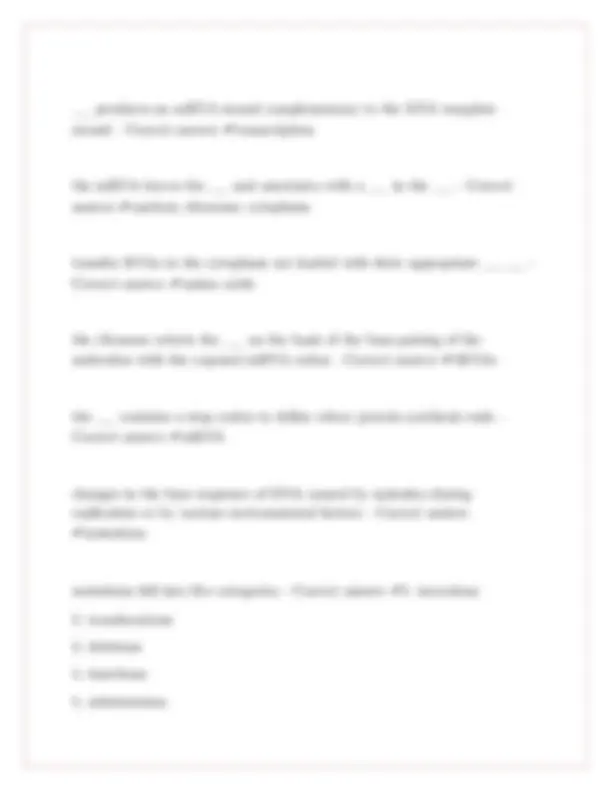

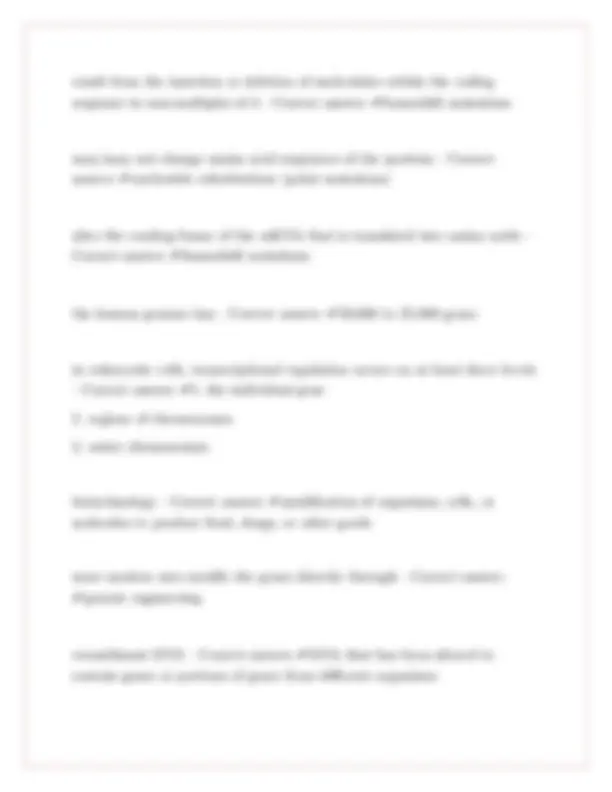


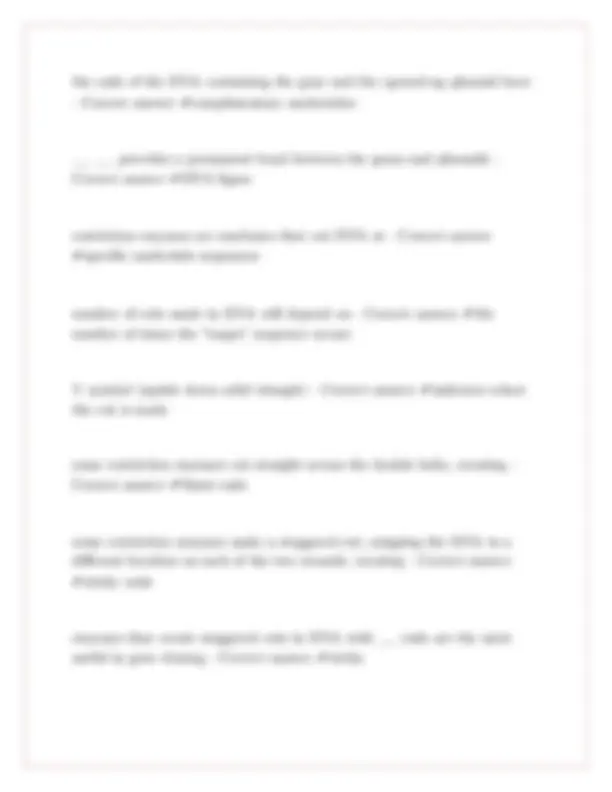
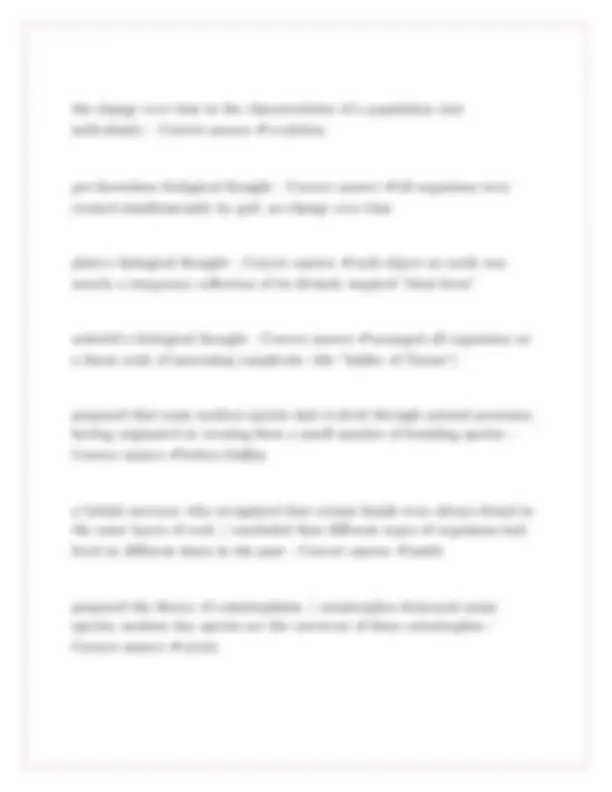

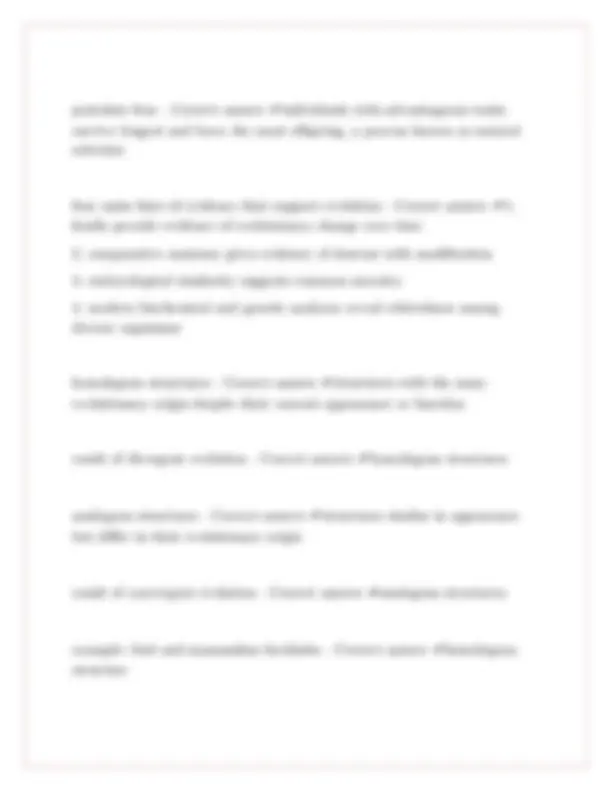
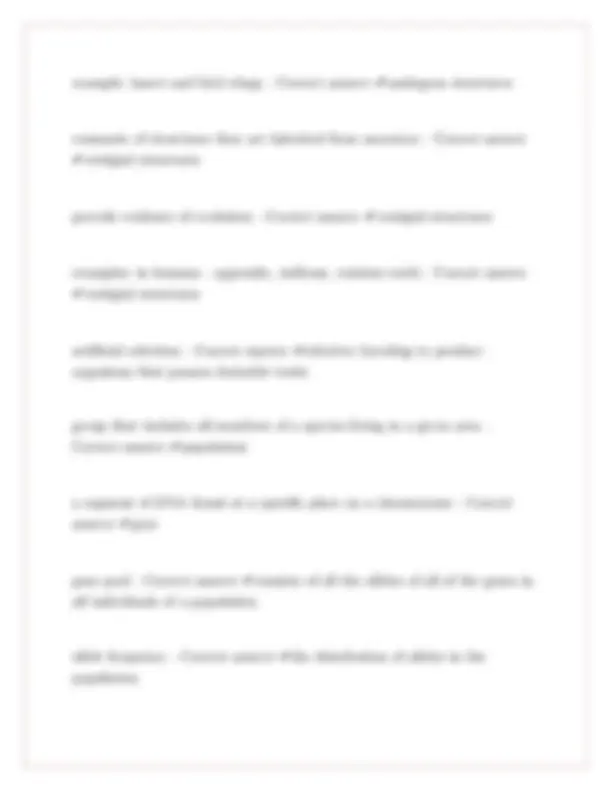

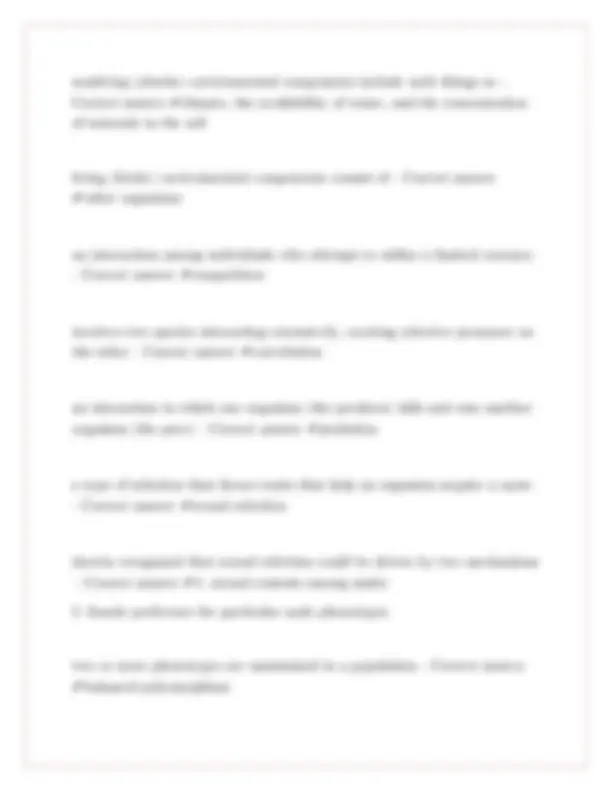


Study with the several resources on Docsity

Earn points by helping other students or get them with a premium plan


Prepare for your exams
Study with the several resources on Docsity

Earn points to download
Earn points by helping other students or get them with a premium plan
Community
Ask the community for help and clear up your study doubts
Discover the best universities in your country according to Docsity users
Free resources
Download our free guides on studying techniques, anxiety management strategies, and thesis advice from Docsity tutors
biol 1001 exam 4 with complete detailed solutions
Typology: Exams
1 / 23

This page cannot be seen from the preview
Don't miss anything!
















DNA |! contains |! the |! ____ |! ____ |! of |! every |! cell |! - |! Correct |! answer |! ✔molecular |! blueprint proteins |! are |! the |! ____ |! ____ |! of |! the |! cell |! - |! Correct |! answer |! ✔construction |! workers proteins |! control |! - |! Correct |! answer |! ✔cell |! shape function reproduction synthesis |! of |! biomolecules there |! is |! a |! flow |! of |! information |! from |! ____ |! to |! _____ |! - |! Correct |! answer |! ✔DNA; |! protein DNA |! in |! eukaryotes |! is |! kept |! in |! the |! - |! Correct |! answer |! ✔nucleus Protein |! synthesis |! occurs |! at |! ____ |! in |! ____ |! - |! Correct |! answer |! ✔ribosomes; |! cytoplasm
DNA |! infor |! is |! carried |! by |! ____ |! from |! the |! nucleus |! to |! the |! cytoplasm |! - |! Correct |! answer |! ✔RNA RNA |! differs |! from |! DNA |! - |! Correct |! answer |! ✔single-stranded uses |! sugar |! ribose base |! uracil messenger |! RNA |! - |! Correct |! answer |! ✔carries |! DNA |! gene |! information |! to |! the |! ribosome single-stranded |! "intermediate |! copy" |! of |! DNA |! - |! Correct |! answer |! ✔mRNA transfer |! RNA |! - |! Correct |! answer |! ✔carries |! amino |! acids |! to |! the |! ribosomes |! for |! addition |! to |! the |! growing |! protein have |! a |! "cloverlead" |! shape |! - |! Correct |! answer |! ✔tRNA ribosomal |! RNA |! - |! Correct |! answer |! ✔part |! of |! the |! structure |! of |! ribosomes each |! ribosome |! consists |! of |! two |! subunits |! - |! one |! small |! and |! one |! large |! - |! Correct |! answer |! ✔rRNA genetic |! information |! is |! transcribed |! into |! ____ |! and |! then |! translated |! into |! ____ |! - |! Correct |! answer |! ✔RNA; |! protein
genome |! is |! small, |! one |! circular |! chromosome |! - |! Correct |! answer |! ✔prokaryote have |! no |! nuclear |! membrane, |! translation |! and |! transcription |! are |! not |! separated |! in |! space |! or |! time |! - |! Correct |! answer |! ✔prokaryote all |! genes |! are |! "back-to-back" |! with |! no |! spacers |! - |! Correct |! answer |! ✔prokaryote entire |! genome |! is |! transcribed |! into |! mRNA, |! and |! then |! translated |! - |! Correct |! answer |! ✔prokaryote dna |! is |! in |! the |! nucleus |! and |! the |! ribosomes |! are |! in |! the |! cytoplasm |! - |! Correct |! answer |! ✔eukaryote genes |! are |! spaced |! out |! over |! long |! distances |! - |! Correct |! answer |! ✔eukaryote regions |! that |! code |! for |! a |! protein |! are |! called |! - |! Correct |! answer |! ✔exons spacer |! regions |! between |! genes |! are |! called |! - |! Correct |! answer |! ✔introns enzymes |! in |! the |! nucleus |! cut |! out |! the |! introns |! and |! splice |! together |! the |! exons |! to |! make |! - |! Correct |! answer |! ✔mature |! mRNA more |! nucleotides |! are |! added |! at |! the |! beginning |! and |! end |! of |! the |! mRNA |! molecule, |! forming |! a |! "cap" |! and |! "tail" |! - |! Correct |! answer |! ✔eukaryote
a |! peptide |! bond |! is |! formed |! between |! methionine |! and |! the |! amino |! acid |! attached |! to |! the |! second |! tRNA |! - |! Correct |! answer |! ✔translation |! elongation the |! "empty" |! tRNA |! is |! released |! and |! the |! ribosome |! moves |! down |! the |! mRNA |! one |! codon |! - |! Correct |! answer |! ✔translation |! elongation a |! third |! tRNA, |! with |! an |! anticodon |! complementary |! to |! the |! third |! codon |! of |! the |! mRNA |! base-pairs |! with |! mRNA |! - |! Correct |! answer |! ✔translation |! elongation this |! tRNA |! attaches |! its |! amino |! acid |! to |! the |! previous |! one |! using |! a |! peptide |! bond |! - |! Correct |! answer |! ✔translation |! elongation translation |! termination |! - |! Correct |! answer |! ✔when |! the |! ribosome |! reaches |! a |! stop |! codon |! in |! the |! mRNA |! molecule, |! releasing |! factors |! cause |! it |! to |! release translation |! termination |! - |! Correct |! answer |! ✔the |! completed |! peptide |! chain, |! mRNA |! and |! ribosomal |! subunits |! no |! longer |! associate |! together translation |! termination |! - |! Correct |! answer |! ✔there |! is |! no |! amino |! acid |! associated |! with |! the |! tRNA |! reaching |! the |! stop |! codon translation |! termination |! - |! Correct |! answer |! ✔a |! sequence |! of |! amino |! acids |! (protein) |! is |! the |! resulting |! product each |! DNA |! gene |! codes |! for |! - |! Correct |! answer |! ✔a |! single |! protein
____ |! produces |! an |! mRNA |! strand |! complementary |! to |! the |! DNA |! template |! strand |! - |! Correct |! answer |! ✔transcription the |! mRNA |! leaves |! the |! ____ |! and |! associates |! with |! a |! ____ |! in |! the |! ____ |! - |! Correct |! answer |! ✔nucleus; |! ribosome; |! cytoplasm transfer |! RNAs |! in |! the |! cytoplasm |! are |! loaded |! with |! their |! appropriate |! ____ |! ____ |! - |! Correct |! answer |! ✔amino |! acids the |! ribosome |! selects |! the |! ____ |! on |! the |! basis |! of |! the |! base-pairing |! of |! the |! anticodon |! with |! the |! exposed |! mRNA |! codon |! - |! Correct |! answer |! ✔tRNAs the |! ____ |! contains |! a |! stop |! codon |! to |! define |! where |! protein |! synthesis |! ends |! - |! Correct |! answer |! ✔mRNA changes |! in |! the |! base |! sequence |! of |! DNA |! caused |! by |! mistakes |! during |! replication |! or |! by |! various |! environmental |! factors |! - |! Correct |! answer |! ✔mutations mutations |! fall |! into |! five |! categories |! - |! Correct |! answer |! ✔1. |! inversions
result |! from |! the |! insertion |! or |! deletion |! of |! nucleotides |! within |! the |! coding |! sequence |! in |! non-multiples |! of |! 3 |! - |! Correct |! answer |! ✔frameshift |! mutations may/may |! not |! change |! amino |! acid |! sequences |! of |! the |! proteins |! - |! Correct |! answer |! ✔nucleotide |! substitutions |! (point |! mutations) alter |! the |! reading |! frame |! of |! the |! mRNA |! that |! is |! translated |! into |! amino |! acids |! - |! Correct |! answer |! ✔frameshift |! mutations the |! human |! genome |! has |! - |! Correct |! answer |! ✔20,000 |! to |! 25,000 |! genes in |! eukaryotic |! cells, |! transcriptional |! regulation |! occurs |! on |! at |! least |! three |! levels |!
transgenic/genetically |! modified |! organisms |! - |! Correct |! answer |! ✔plants |! and |! animals |! that |! express |! DNA |! that |! has |! been |! modified |! or |! derived |! from |! other |! species bacteria |! pick |! up |! pieces |! of |! DNA |! from |! the |! environment |! in |! - |! Correct |! answer |! ✔transformation this |! DNA |! picked |! up |! in |! transformation |! could |! be |! part |! of |! a |! chromosome |! from |! another |! bacterium |! or |! tiny |! circular |! DNA |! molecules |! called |! - |! Correct |! answer |! ✔plasmids small |! pieces |! of |! DNA, |! not |! included |! in |! chromosomes, |! that |! may |! be |! present |! in |! bacteria |! in |! multiple |! copies |! - |! Correct |! answer |! ✔plasmids carry |! genes |! that |! help |! the |! bacteria |! survive |! in |! novel |! environments |! or |! where |! antibiotics |! are |! present |! - |! Correct |! answer |! ✔plasmids viral |! reproduction |! - |! Correct |! answer |! ✔1. |! attaches |! to |! specific |! molecules |! on |! the |! surface |! of |! a |! suitable |! host |! cell
repetition |! of |! the |! cycle |! - |! Correct |! answer |! ✔the |! cycle |! is |! repeated |! automatically |! (by |! a |! thermocycler |! machine) |! for |! 20-30 |! cycles, |! producing |! up |! to |! 1 |! billion |! copies |! of |! the |! original |! targeted |! DNA |! sequence gel |! electrophoresis |! - |! Correct |! answer |! ✔a |! technique |! used |! to |! separate |! out |! DNA |! fragments |! of |! varying |! lengths |! in |! a |! mixture can |! be |! used |! to |! identify, |! isolate, |! and |! modify |! genes |! - |! Correct |! answer |! ✔biotechnology combine |! genes |! from |! different |! organisms |! - |! Correct |! answer |! ✔biotechnology move |! genes |! from |! one |! species |! to |! another |! - |! Correct |! answer |! ✔biotechnology three |! major |! steps |! involved |! in |! making |! GMOs |! - |! Correct |! answer |! ✔1. |! obtain |! the |! desired |! gene
once |! the |! gene |! is |! obtained, |! it |! can |! be |! used |! to |! create |! a |! - |! Correct |! answer |! ✔transgenic |! organism DNA |! cloning |! - |! Correct |! answer |! ✔the |! simplest |! method |! to |! generate |! various |! copies |! of |! the |! gene |! in |! large |! quantities the |! most |! common |! method |! of |! DNA |! cloning |! is |! to |! - |! Correct |! answer |! ✔insert |! the |! gene |! into |! a |! bacterial |! plasmid, |! which |! will |! replicate |! when |! bacteria |! containing |! plasmid |! multiply using |! ____ |! ____, |! genes |! are |! inserted |! into |! plasmids |! - |! Correct |! answer |! ✔restriction |! enyzmes restriction |! enzymes |! - |! Correct |! answer |! ✔recognize |! certain |! sequences |! and |! they |! clip |! DNA |! at |! those |! certain |! sequences straight |! cuts |! - |! Correct |! answer |! ✔blunt |! ends staggered |! cuts |! - |! Correct |! answer |! ✔sticky |! ends restriction |! enzymes |! are |! used |! to |! insert |! a |! gene |! into |! a |! plasmid |! by |! - |! Correct |! answer |! ✔cutting |! the |! DNA |! on |! both |! sides |! of |! the |! gene |! and |! splitting |! open |! the |! circle |! of |! the |! plasmid
transfecting |! - |! Correct |! answer |! ✔inserting |! the |! gene |! into |! the |! host |! organism |! and |! having |! it |! be |! expressed |! in |! the |! appropriate |! cells, |! at |! the |! appropriate |! times |! and |! at |! the |! desired |! level the |! recombinant |! plasmids |! can |! be |! inserted |! into |! harmless |! bacteria |! or |! viruses |! called |! - |! Correct |! answer |! ✔vectors about |! ____% |! of |! the |! corn, |! cotton, |! and |! soybeans |! grown |! in |! the |! U.S. |! are |! transgenic |! - |! Correct |! answer |! ✔85% globally, |! almost |! ____ |! ____ |! acres |! of |! land |! were |! planted |! with |! transgenic |! crops |! in |! 2007 |! - |! Correct |! answer |! ✔ 300 |! million crop |! plants |! are |! commonly |! modified |! to |! improve |! ____ |! and |! ____ |! resistance |! - |! Correct |! answer |! ✔insect; |! herbicide genes |! make |! up |! less |! than |! ____ |! % |! of |! the |! total |! DNA |! - |! Correct |! answer |! ✔2% there |! are |! around |! ____ |! protein |! coding |! human |! genes |! - |! Correct |! answer |! ✔20, restriction |! enzymes |! may |! cut |! different |! alleles |! of |! a |! gene |! at |! different |! locations, |! yielding |! - |! Correct |! answer |! ✔distinctive |! fragments |! characteristic |! of |! one |! allele |! or |! the |! other
restriction |! fragment |! length |! polymorphisms |! (RFLPs) |! - |! Correct |! answer |! ✔when |! homologous |! chromosomes |! have |! different |! alleles, |! they |! may |! produce |! different |! numbers |! of |! fragments |! when |! cut |! by |! restriction |! enzymes can |! be |! detected |! and |! the |! patterns |! observed |! can |! be |! used |! to |! diagnose |! the |! presence |! or |! absence |! of |! various |! alleles |! - |! Correct |! answer |! ✔RFLPs can |! be |! used |! in |! forensics |! to |! compare |! two |! DNA |! samples |! - |! Correct |! answer |! ✔RFLPs method |! used |! in |! prenatal |! genetic |! screening |! where |! the |! amniotic |! fluid |! from |! a |! mother's |! uterus |! is |! collected |! and |! tested |! - |! Correct |! answer |! ✔amniocentesis method |! used |! in |! prenatal |! genetic |! screening |! where |! small |! parts |! of |! a |! pregnant |! woman's |! placenta |! are |! removed |! and |! tested |! - |! Correct |! answer |! ✔chorionic |! villus |! sampling how |! does |! genetic |! engineering |! differ |! from |! selective |! breeding? |! - |! Correct |! answer |! ✔- |! GE |! is |! much |! more |! rapid
considered |! the |! forces |! of |! wind, |! water, |! earthquakes, |! and |! volcanoes |! - |! Correct |! answer |! ✔hutton |! and |! lyell hutton |! and |! lyell |! developed |! the |! theory |! of |! uniformitarianism, |! which |! states |! that |! - |! Correct |! answer |! ✔geologic |! change |! resulted |! from |! slow, |! continuous |! actions |! similar |! to |! those |! at |! work |! today proposed |! that |! organisms |! evolved |! through |! the |! inheritance |! of |! acquired |! characteristics |! - |! Correct |! answer |! ✔lamarck theorized |! that |! organisms |! are |! modified |! during |! their |! lifetime |! through |! "use |! or |! disuse" |! of |! different |! parts |! - |! Correct |! answer |! ✔lamarck proposed |! that |! life's |! diverse |! forms |! arose |! through |! the |! process |! of |! descent |! with |! modification |! - |! Correct |! answer |! ✔darwin |! and |! wallace darwin |! and |! wallace's |! theory |! rests |! on |! - |! Correct |! answer |! ✔four |! postulates postulate |! one |! - |! Correct |! answer |! ✔variation |! in |! a |! population postulate |! two |! - |! Correct |! answer |! ✔some |! of |! the |! differences |! between |! members |! of |! a |! population |! are |! due |! to |! inherited |! characteristics postulate |! three |! - |! Correct |! answer |! ✔differential |! survival |! and |! reproduction |! in |! each |! generation
postulate |! four |! - |! Correct |! answer |! ✔individuals |! with |! advantageous |! traits |! survive |! longest |! and |! leave |! the |! most |! offspring, |! a |! process |! known |! as |! natural |! selection four |! main |! lines |! of |! evidence |! that |! support |! evolution |! - |! Correct |! answer |! ✔1. |! fossils |! provide |! evidence |! of |! evolutionary |! change |! over |! time